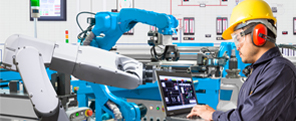The Changing Attitude
Toward Basic Maintenance
Lowest cost is no longer top criteria
By Chris Fisk, President, Acculube
In my 15 years of providing manufacturers with the latest lubricants and industrial cleaners, one thing has been consistent: the customer often preferred the cheapest product possible that would get the job done.
But in the past year, many customers have changed their thinking.
Today, manufacturers want to drive down total maintenance costs by buying better and smarter products.
Why the sudden change? And how can manufacturers buy smarter? Here are my thoughts.
Strong Labor Market
Google-search "manufacturing news" and you will inevitably see at least one article on the shortage of skilled U.S. manufacturing workers. This skill shortage is compounded in maintenance professionals. During the recession of 2008-2010, many skilled maintenance workers were no longer needed. Many of these maintenance workers participated in government-sponsored retraining programs for different careers. Those workers have moved on and are unlikely to return.
Meanwhile, manufacturing equipment is becoming more complex, technical, and computerized. Companies need maintenance personnel who understand basic mechanical engineering.
That said, it's no surprise that salaries are rising. Two years ago, the most recent data showed that the average industrial machinery mechanic in the United States earned a little less than $21 an hour. Today, it's $24.75 an hour. It's no wonder companies are strategizing how to keep maintenance personnel assigned to tasks that directly impact machine performance, and less on basic maintenance.
Rising costs and limited maintenance personnel have changed how manufacturers make plant decisions. The question now is:
How can we operate at full capacity with less maintenance labor?
Here are some of the most effective strategies:
1. Look for equipment with longer service intervals
Obviously, you'll need to do a proper return on investment analysis. These machines are often purchased brand-new, are thus more expensive. However, the savings in time, warranty protections, and lower maintenance can be well worth the premium, not to mention the gains in increased functionality and programming capabilities.
2. Consider an automatic lubrication system
An automatic lubrication system greases or lubricates multiple points on a machine on the time interval you specify. It uses small cartridges that can last up to a year. Maintenance personnel are only needed to swap out the dispensing unit or in the rare occurrence of a system failure.
3. Look for lubricants that last longer than three years or fill for life applications
Cheaper, basic lubricants often must be changed every few months or require a machine to be greased quarterly. New lubricant technologies, on the other hand, can be tested once a year and changed only when required. For example, with synthetics and high-performance lubricants, you only have to dispose of the old and buy new every three years. It takes as little as 15 minutes to test and only a couple of hours to drain and refill. New technology lubricants can also better protect machines from oxidation and high temp damage as well as wear.
Quality maintenance personnel are a valuable asset to any manufacturing operation. Regrettably, there simply aren't enough of them to go around. New maintenance strategies and new product technologies can help these skilled professionals complete more maintenance work in less time.
ABOUT THE AUTHOR: Chris Fisk is President of Acculube, a Dayton-Ohio based supplier of metalworking and manufacturing fluids to American manufacturers, machine shops and vehicle fleets.
NEXT ESSAY
 |
|
Ask us today how we can help you get maintenance work done faster and more effectively! Email Acculube or call us at 1.800.404.2570.
|
|


